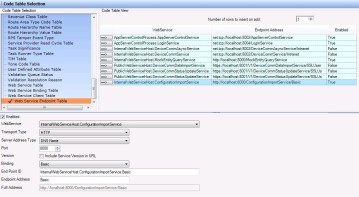Web service endpoint code table
The web service endpoint code table defines values for configuring endpoints to Web services. Each Web service must each have a minimum of one endpoint configured.
Use the following procedure to configure the Web Service Endpoint Code Table:
-
Go to System Administration > System Admin > Code Table Setup.
-
From the Code Table Selection list, click Web service endpoint code table.
-
Use the Number of rows to insert on add dropdown menu to select the number of blank rows to add to the code table. Create one blank row for each web service endpoint you are configuring.
-
From the Code Table Setup menu, click Add. The new rows appear in the table.
-
Click
 to select a blank row.
to select a blank row. -
Configure the following parameters:
-
Enabled. Determines whether the endpoint is enabled and the service accepts incoming traffic on that endpoint. Select the checkbox to enable the endpoint. Leave blank to disable.
-
Web Service. Defines the web service to which the endpoint is added.
-
Transport Type. Defines the endpoint transport type. The transport type options include the following:
-
HTTP. Transport using interoperable HTTP protocol with no transport level security.
-
HTTPS. Transport using interoperable HTTP protocol with SSL security.
-
MSMQ. Transport using Microsoft Message Queue.
-
TCP. Transport using proprietary TCP/IP-based protocol to connect .NET clients and services.
-
-
Server Address Type. Defines the way the server that runs the Web service is identified in the Web service endpoint address. Use the dropdown menu to select a value. The valid values are as follows:
-
DNS Name. The network name of the server.
-
Fully-Qualified Name. The fully-qualified network name of the server including the domain suffix.
-
IP Address. The IP address of the server.
-
-
Port Number. Defines the port where the web service This is disabled when the Web service’s Service Process is IIS.
-
Include Service Version in URL. Determines whether to include the web service’s major version in the endpoint address. Select the checkbox to include.
-
Binding. Defines the web service binding.
-
Primary Endpoint ID. Unique identifier for this configuration record. The Web service client attempts to connect to the web service at this endpoint until either the number of retries is reached or timeout occurs. If the client cannot reach the Primary Endpoint ID, the client tries again using the Backup Endpoint ID.
-
Backup Endpoint ID. The endpoint ID the web service client attempts to connect to if the Primary Endpoint ID cannot be reached.
-
(Optional) Endpoint Address. A relative endpoint address to append to the full address. Based on this parameter, the full address to the endpoint appears.
-
-
Click Save.
